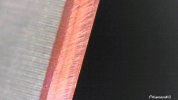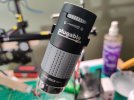eKretz - I will be scraping 2 cast iron adapter plates that go between the 2 rotary axes and the machine tables on a new cnc mill I got recently. The hole patterns on the rotaries and the table, no t-slots, don't line up so an adapter plate is a must. I have scraped aluminum before with files but this is the first for carbide and cast iron. The scrapers are Sandvicks as well as the blades, both 20mm and 30mm sizes with 40mm and 90mm radiuses. How polished should the edges be? The 650 at 2500ish rpm leaves a pretty smooth finish but I can go down to 1.5 micron in many steps of resin bond diamond cup wheels.
barkingspider - I doubt your carbide blade is as fragile and prone to chipping as even white Kyocera ceramic, probably closer to a SS Maxamet in a S90V flavor, if such existed. Don't get in a hurry, back and forth strokes with the coarser stones, edge trailing as you get a fairly fine apex, you will know when the microchips start getting worse instead of better. I don't know if you will need to go to a strop like you do with ceramic. I would say use your Matrix stones from the 80 to the 4000 as needed, making sure you remove the scratches from the last grit, and go from there. I like to raise my angle .2 degrees or so for the last 2 stones to make sure I am truly reaching the apex with them instead of just polishing the bevel. If you do this just use very light pressure, and do check for microchipping under the microscope as you can't do this with stones on ceramic, but strops work great. I would try finishing with bare leather just in case there is any foil burr since fine diamonds like to leave them, and 20% binder is a lot which may leave a burr.
I really don't think you will get a burr. This is where a good microscope is so nice to have as you can see what is happening when you can't quite feel it.
I think you can get a finer edge with your manual sharpener than powered so I wouldn't be thinking of using anything other than what you have. The only thing I might add is using wather carrier diamond loaded leather dry, or bass wood, as the strop to use after the stones.





